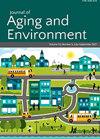Development and Validation of a Checklist to Assess the Elderly Attitude toward the Environmental Indicators (EA-EIs) of Nursing Home Facilities
IF 1
Q3 GERONTOLOGY
引用次数: 0
Abstract
Abstract Introduction Long term care public centers have not been fully established in Iran; elderly patients still cannot obtain the necessary care in their community. The main aim of this study was to develop and validate a checklist for assessing the elderly attitude toward the environmental indicators of public long-term care facilities. Method The tool contains 46 items across six domains developed through semi-structured interviews with the elderly attending public places across the city. In total, 400 elderly patients aged ≥60 years living in Ilam city selected through purposive sampling design. Six subscales, including medical facilities, health facilities, welfare, independence, control, and human relation, were driven. The elderly's attitude toward the environmental indicators of long-term care facilities checklist (EA-EIs) internal consistency, test-retest reliability, and factorial validity was analyzed. Results Explanatory factor analysis confirmed the presumed theoretical model correctly and the following six factors identified through the tool: (a) medical facilities (7 items), (b) health facilities (4 items), (c) welfare (14 items), (d) independence (10 items), (e) control (7 items), and (f) human relation (4 items). Internal consistency yielded high Cronbach alpha values for all six domains and the total overall, suggesting a stable and reliable measure. Two weeks of test-retest reliability for the tool found to be acceptable. Conclusion The present study provides preliminary evidence that (EA-EIS) is a reliable and valid instrument to the efficient assessment of elderly attitude toward the environmental indicators of public nursing home facilities. This instrument should be valuable for public health research as well as health service use.评估长者对安老院舍环境指标态度的检查表之编制及验证
伊朗长期护理公共中心尚未完全建立;老年病人仍然无法在他们的社区获得必要的护理。本研究的主要目的是开发并验证一份评估老年人对公共长期照护机构环境指标态度的清单。方法该工具包含6个领域的46个项目,通过对城市公共场所老年人的半结构化访谈开发而成。通过目的抽样设计,选取伊拉姆市≥60岁的老年患者400例。以医疗设施、卫生设施、福利、独立性、控制、人际关系等六个分量表为驱动力。分析老年人对长期照护设施环境指标表(EA-EIs)内部一致性、重测信度和析因效度的态度。结果解释因子分析正确地证实了假设的理论模型,并通过工具确定了以下六个因素:(a)医疗设施(7个项目),(b)卫生设施(4个项目),(c)福利(14个项目),(d)独立性(10个项目),(e)控制(7个项目)和(f)人际关系(4个项目)。内部一致性产生高Cronbach alpha值为所有六个领域和总体,表明一个稳定和可靠的测量。经过两周的重新测试,发现该工具的可靠性是可以接受的。结论(EA-EIS)是一种可靠、有效的工具,可以有效地评估老年人对公办养老院环境指标的态度。这一工具对于公共卫生研究和卫生服务的使用应该是有价值的。
本文章由计算机程序翻译,如有差异,请以英文原文为准。
求助全文
约1分钟内获得全文
求助全文
来源期刊

Journal of Aging and Environment
Social Sciences-Sociology and Political Science
CiteScore
2.50
自引率
5.00%
发文量
21
 求助内容:
求助内容: 应助结果提醒方式:
应助结果提醒方式:


